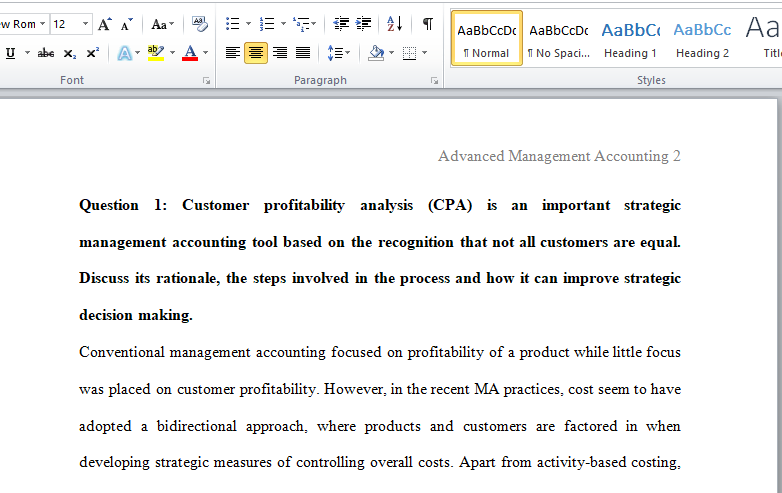Explain advanced management accounting
Advance management accounting
1.Customer profitability analysis (CPA) is an important strategic management accounting tool based on the recognition that not all customers are equal. Discuss its rationale, the steps involved in the process and how it can improve strategic decision making.
- Introduction & Rationale
- Traditional focus of MA: product profitability – little focus on customer profitability
- Some highly profitable, others may be unprofitable
- Reasons include ………
- Steps
- Segment customer base (e.g. geographically by product or industry type)
- Calculate annual revenue attributable to each segment
- Calculate costs attributable to each segment (using ABC)
- Identify profitable & unprofitable segments
- Develop customer strategies
- Decision making
- Improve pricing & marketing decisions
- Develop relationships with highly profitable customers
- Eliminate unprofitable customers
- Turn loss-making customers into profitable customers
- Conclusion
2.Outline the historical development of strategic management accounting and assess its success to date.
- Introduction (2)
- Pre 1980s scenario (2)
- 1980s criticism – reasons (4)
- Evaluation of success (2 marks per developed point) – max 10 marks
- Some tools widely adopted & significant impact (e.g. BSC)
- that have implemented SMA tools recognise benefits
- But low levels of adoption for others (e.g. attribute costing)
- Little agreement over definition
- Many scholars advocating
- But others claim techniques already in use by others (e.g. marketing)
- Growing literature, teaching & awareness
- Conclusion – But need more research & evidence needed
3.The role of the management accountant has changed significantly in the past thirty years. Highlight the drivers of these changes, the impact on the role and additional skills required.
- drivers – globalization, competition, IT advances, technology (life cycles). decentralisation etc. (1 mark per point max 4 marks)
- impact –more future orientated, more external focus, focus on longer term, more strategic & less operational, hybrid role, business partner (1 mark per point max 4 marks)
- skills – strategic, analytical, communication, commercial awareness etc. (1 mark per point max 4 marks)
- Hybrid: trad. + business partner (4 marks)
- Presentation & structure (4 marks)
4.“In today’s competitive and rapidly changing marketplace, it is important for manufacturers to develop and market products that not only meets the customers demand for features at a certain price level but also generate the desired profits.”
Recommend two strategic cost accounting techniques that can help organisations achieve these objectives.
Students to discuss two (ii) target costing and (iii) life cycle costing
Target costing
- Cost plus pricing not feasible in competitive markets
- TC starts with market research to determine customer demand & price
- Price established, required margin deducted to establish target cost
- Find ways not to exceed target cost
- Focus on design phase (where costs committed) – determine product features, materials needed, product quality, machining / assembly, sub-contract, batch size etc.
- Cross-functional team approach is essential
Life cycle costing
- Traditional product costs only include current costs (DM + DL + PO)
- Ignores pre & post production costs (e.g. R&D, decommissioning)
- Particularly relevant because of shorter product life cycles
- To make a profit on a product over its lifetime, total revenue must exceed total costs
- LCC included all costs, including those incurred before, during or after the product is produced
- All costs should be considered in;
- determining product cost, selling price, product profitability
- initial capital investment appraisal decision
- “Traditional strategic planning is a waste of time, It is impossible to predict the future in the world we now live in, so why bother trying?” Evaluate the above statement, discussing the limitations of the traditional strategic planning process—-alternative approach
Answer preview:

Words:1,778
